5 Mnemonic Strategies to Help Students Succeed in School
April 25, 2017
At some point in your life, you’ve probably remembered an important fact with the help of mnemonics: memory-enhancing strategies that link a new word or concept to information you already know. Use of mnemonics is a highly effective way to help students (with and without disabilities) recall and retrieve the new information you teach. They’re fun, easy to learn and use, and cost you nothing to implement. And once you teach kids mnemonics, they can use and adapt these tools for the rest of their lives to keep important information from slipping through their fingers.

Today’s post shares 5 specific mnemonic strategies you can use in your classroom right away. Excerpted and adapted from Adolescent Literacy (edited by Richard T. Boon & Vicky Spencer), these suggestions will help all your students learn new academic content and succeed in school. (Do you have a favorite mnemonic strategy of your own? Share it in the comments below!)
Keyword Mnemonics
Learning new vocabulary words and facts can be easier when students connect the new information with something that’s already familiar to them. The keyword method links a new word or concept to an easily recognized known word that sounds similar. The student creates a visual image depicting this connection, which makes the new information easier to store and retrieve as needed.
Examples of keyword mnemonics:
- Say your students need to learn the words for two different parts of the brain: cerebrum and cerebellum. Since the cerebrum is larger than the cerebellum, the keyword for cerebrum could be drum (a large instrument) and the keyword for cerebellum could be bell (a small instrument). Help your students remember that the cerebrum is the largest part of the brain by connecting it with the image of a drum, which makes a big sound and takes up a large amount of space. You can even draw a picture of a large drum in the brain where the cerebrum is located.
- To help students remember that Olympia is the capital of Washington, assign keywords or keyword phrases to both words. Say the keyword phrase for Washington is “wash-a-ton,” and the keyword for Olympia is the Olympics. Your students can think about people at an Olympic event washing a ton of their laundry—an unusual image that will help the new fact “stick.”
- This strategy works especially well when you’re teaching challenging new vocabulary words. If you’re teaching the word “assail,” for example, use “sailboat” as the keyword to associate the new word with. Students can think of a sailboat crashing into someone to remember that “assail” means to attack someone with words or actions.
Pegword Rhyming Mnemonics
Pegwords—words on which new information can “hang”—are another effective way to link new information with familiar information. Using this strategy, the student learns rhymes that can be easily connected with new words, facts, or numbers.
Examples of pegword rhyming mnemonics:
- To help students remember Newton’s three laws of motion, make up pegword rhymes that correspond with each of the three steps. One is “bun”: the bun does not move until someone or something touches it (inertia). Two is “flew”: the airplane flew at the same speed until the wind became stronger (an object maintains velocity unless something acts on it to increase the speed). Three is “glee”: the child was full of glee one moment and then began to cry (for every action there is an opposite and equal reaction).
- Students who struggle with multiplication facts can be taught pegwords for the numbers being multiplied. To teach the math fact 6 x 6, teach the student to associate the pegword sticks with six. The mnemonic “sticks times sticks” would prompt the student to think of six sticks bundled together six times. Additional pegwords (“30 is dirty”) can help students remember answers to multiplication facts; for example, 6 x 6 (sticks x sticks) = 36 (dirty sticks).
- Using pegword rhymes in the social studies classroom can help students remember important dates and facts. Sometimes using a rhyming pattern of words can make memorization easier and more fun. For example, to help students remember when the final two states were admitted into the Union, teach them the rhyme: ’59 was the date/When Alaska and Hawaii became new states.
Acronym Mnemonics
Acronyms are one of the most popular and widely used mnemonic strategies. Using this method, students memorize a single word in which each letter is associated with an important piece of information. This letter-association strategy is especially useful for remembering short lists of items or steps.
Examples of acronym mnemonics:
- To help students remember the names of the five Great Lakes, share the acronym mnemonic HOMES with them: Huron, Ontario, Michigan, Erie, Superior. You can help students create a link between the mnemonic and the new information with a script like this: “If you get rid of all the letters of the lakes except the first letter in each name, you get HOMES. Think of all the homes that people live in right next to the Great Lakes. Because it’s very cold in the north, you need to live in a home to stay warm and cozy. When you think of all the HOMES near the Great Lakes, you’ll remember their names.”
- If you’re teaching the different steps of the scientific method, students can use the acronym mnemonic HOMER to help them remember the steps in order: hypothesize, operationalize, measure, evaluate, and replicate.
Acrostic Letter Sentence Mnemonics
Acrostic letter mnemonics are similar to acronyms, except students memorize a simple silly sentence instead of a word to trigger their memory. The first letter of each word in the sentence correlates with an important fact they’re trying to remember. This is another great way to help students remember several pieces of interconnected information.
Examples of acrostic letter sentence mnemonics:
- Use the sentence Sara’s Hippo Must Eat Oranges to help students remember the names of the Great Lakes in order of size: Superior, Huron, Michigan, Erie, Ontario. (To help students connect the sentence to the lakes, tell them to imagine that Sara lives near one of the lakes and think about how silly it is that an orange-eating hippo lives there, too.)
- The sentence Never Eat Sour Watermelon can help students remember the directions on a compass: North, East, South, West. Teach students to start at the top of the compass and say the silly sentence as they label the directional points in a clockwise fashion.
- To help students visualize and remember the order of the first five American presidents, teach them the sentence Washington’s Army Jogged Many Miles. This will help them remember the first five presidents: Washington, Adams, Jefferson, Madison, and Monroe.
Combination Mnemonics
Mnemonic methods can also be combined—use keywords and acronyms together, for example, to form an extra-effective mnemonic super-strategy.
Say your students are trying to memorize key facts about the Civil War. You can create a map-like display and enhance it with mnemonics to help them recall the information. Use keywords for battle names, acrostic letter sentences to help them remember events in order, and pegword rhymes to associate with important Civil War figures. Get creative and consult your learners for ideas!
***
Start out by giving your students clear instruction on these and other mnemonic strategies. Once they’ve got the strategies down, they can create their own—and use them across content areas to master new information and become more independent, efficient learners.
Have a favorite mnemonic strategy to share? Add it below!
GET THE BOOK
Help improve adolescents’ comprehension skills across content areas with this book, developed for teachers of students in Grades 6-12 with and without disabilities.




Write a Comment
Your email address will not be published. Required fields are marked *
comments
Mindvalley says
Very thoughtful post on mind .It should be very much helpful.
https://blog.mindvalley.com/cerebrum-vs-cerebellum/
Swati Kohli says
Excellent great ideas given,a creative teacher can come up with many!
Amanda Harmon says
Here are a few more memorization techniques that work: https://www.bookwidgets.com/blog/2016/12/9-amazing-tricks-to-teach-your-students-to-memorize In my experience, for each type of learner (visual, auditory, etc.) different techniques may work, and it is important for us to find an approach and teach these techniques to the children.
Maryann N. Gomez says
Thank you for sharing these helpful strategies!
I
Post a Comment